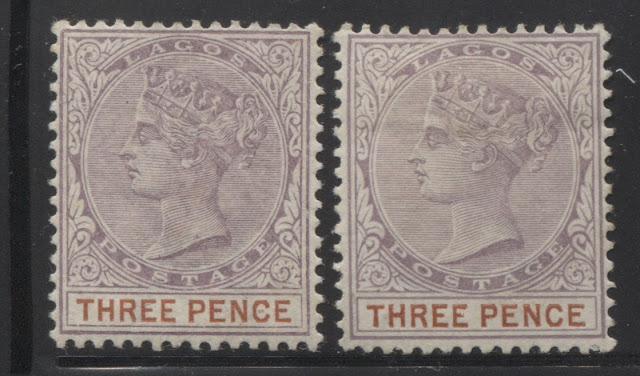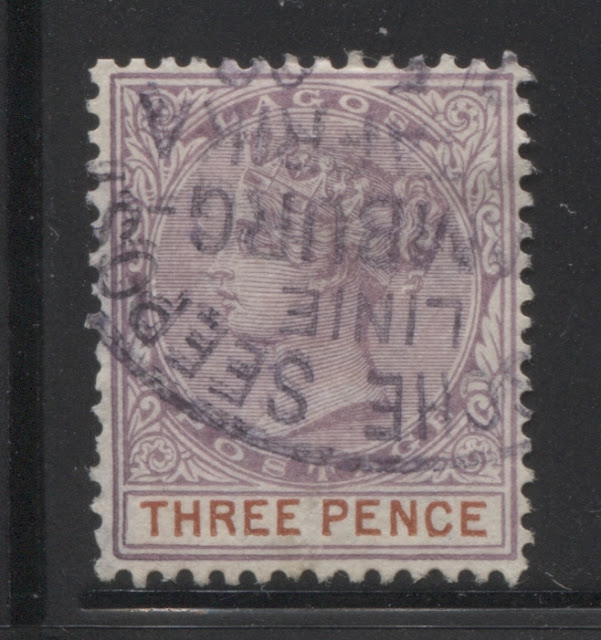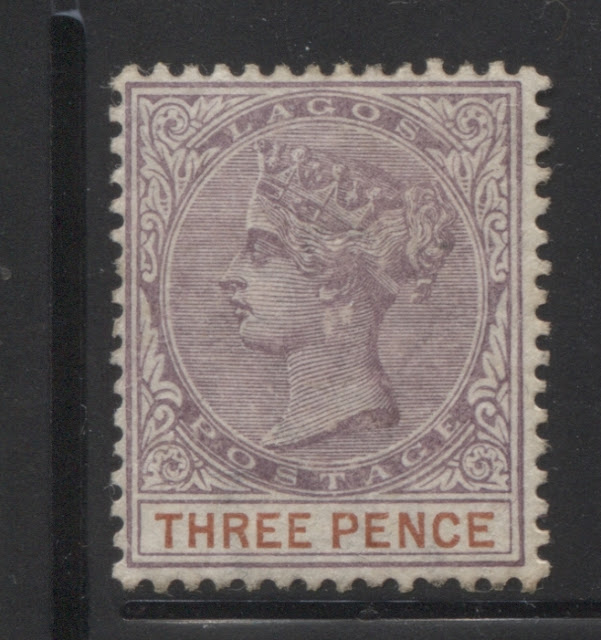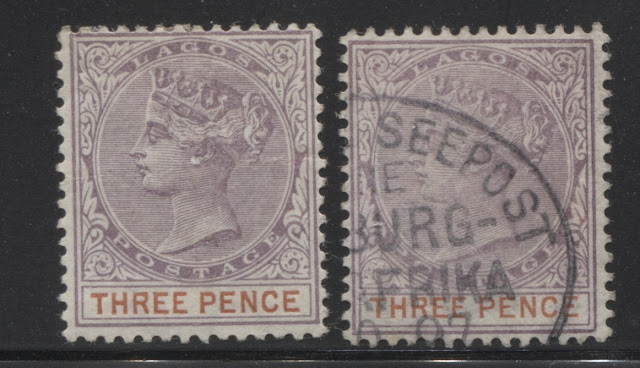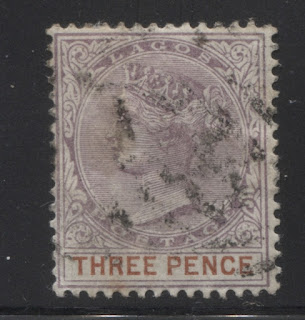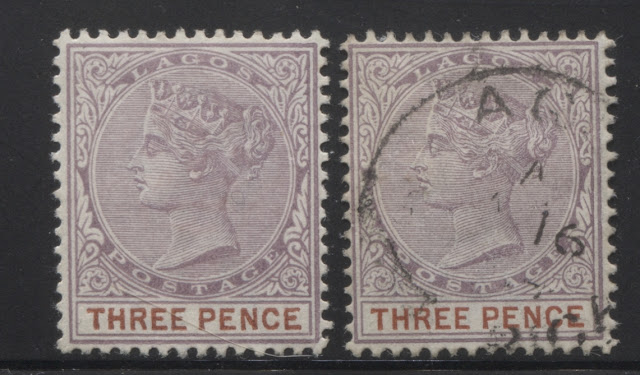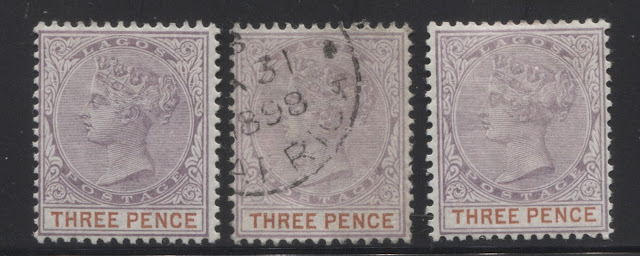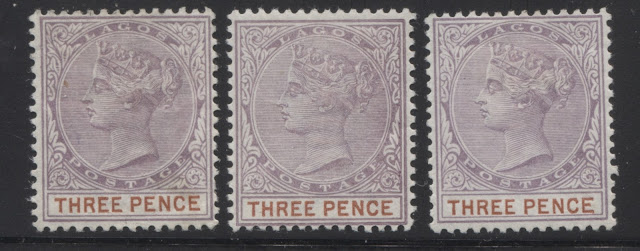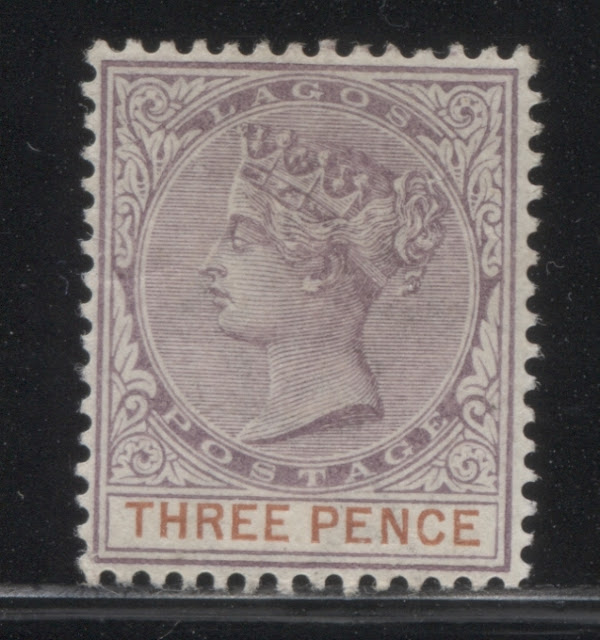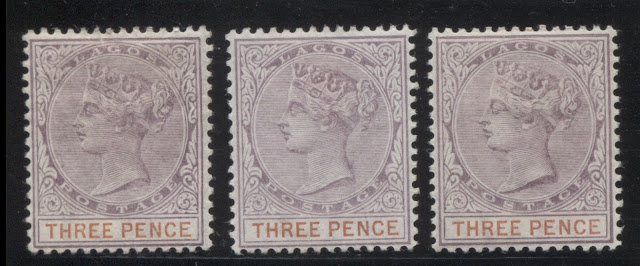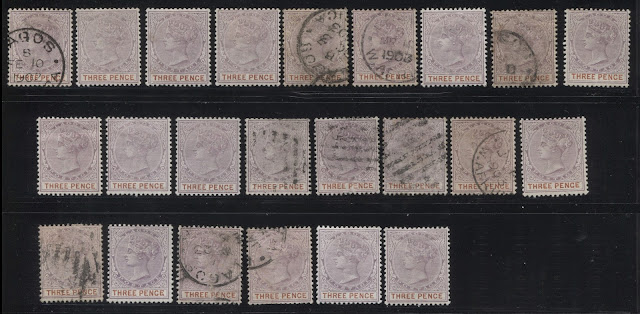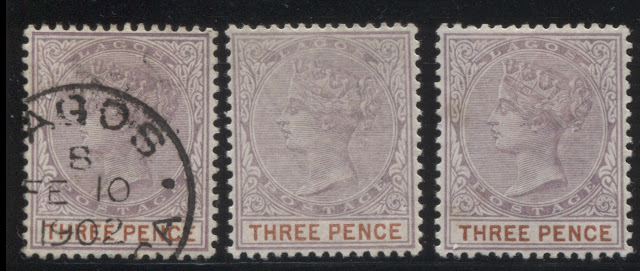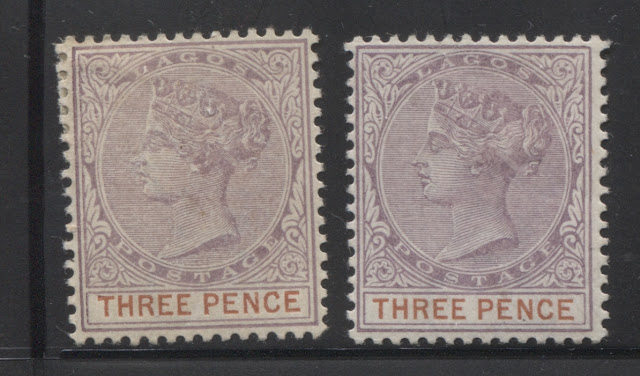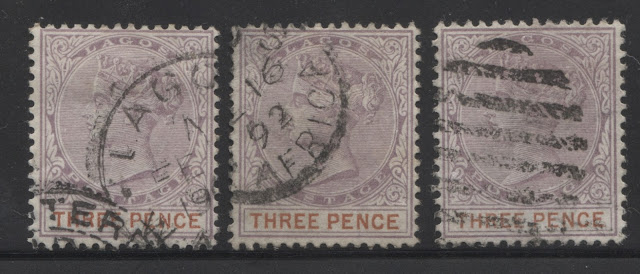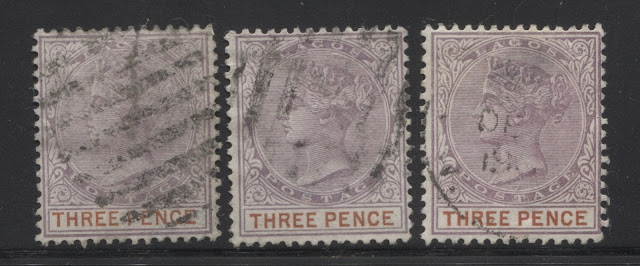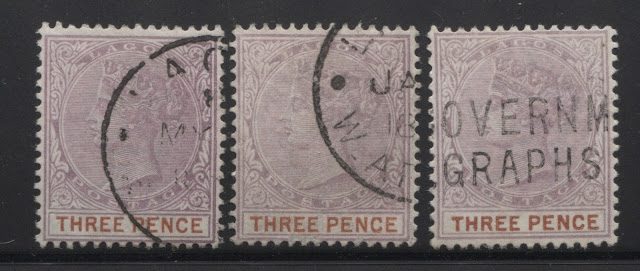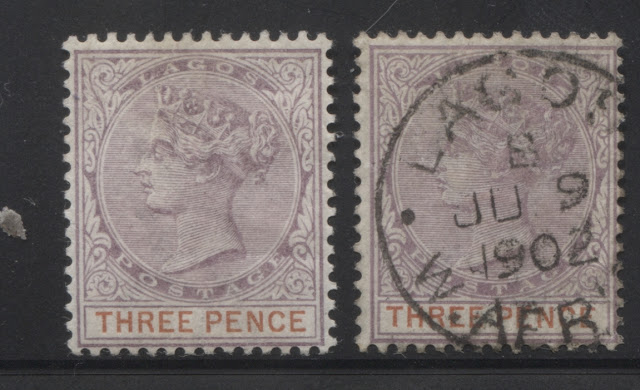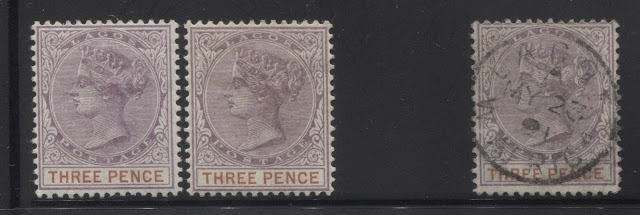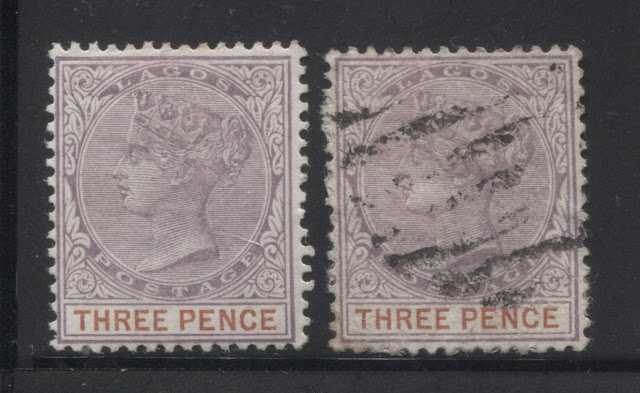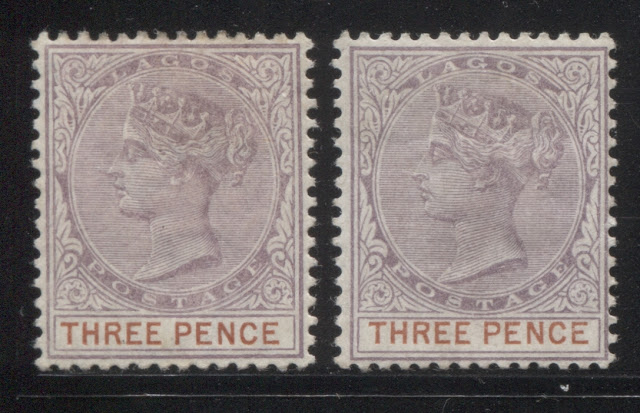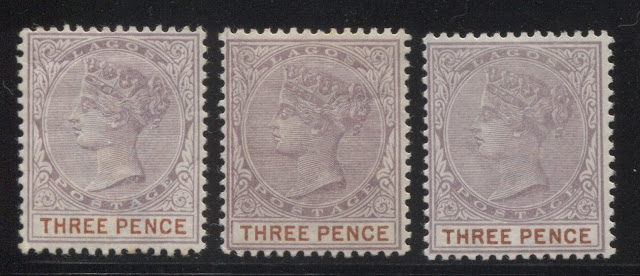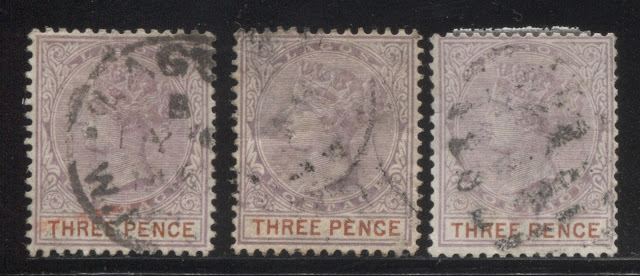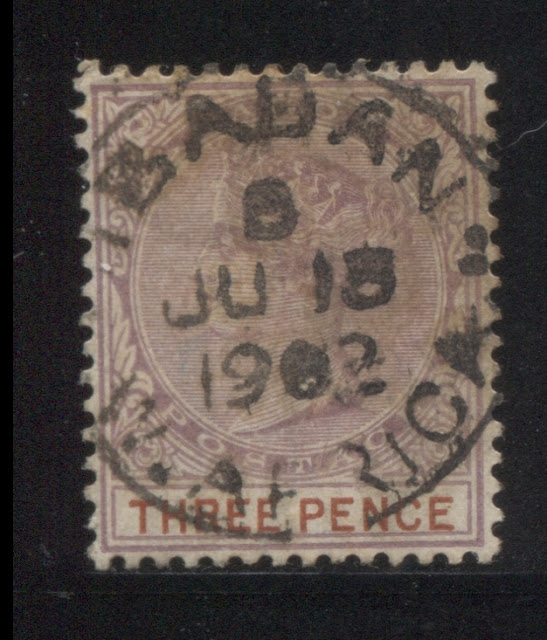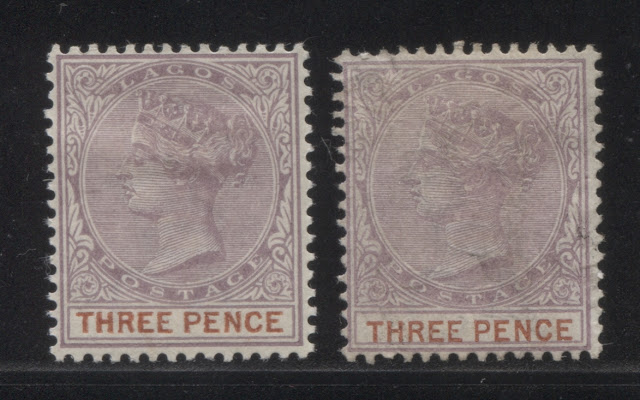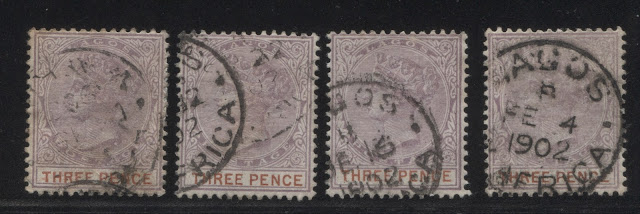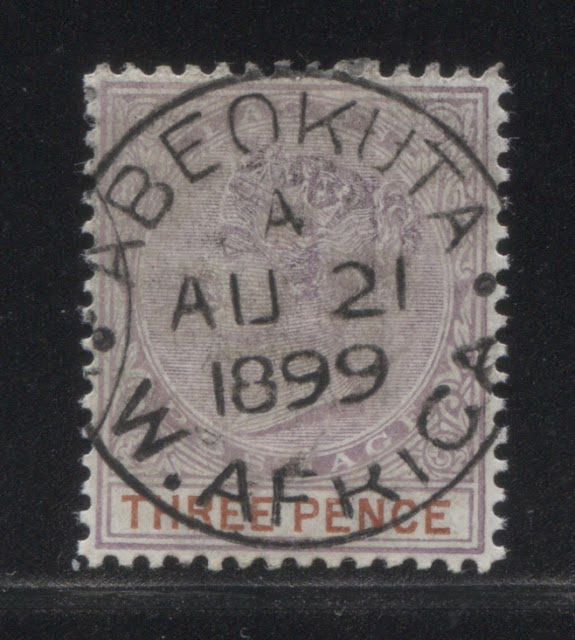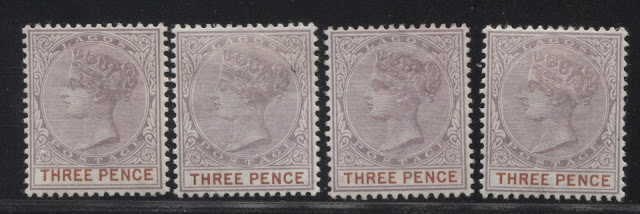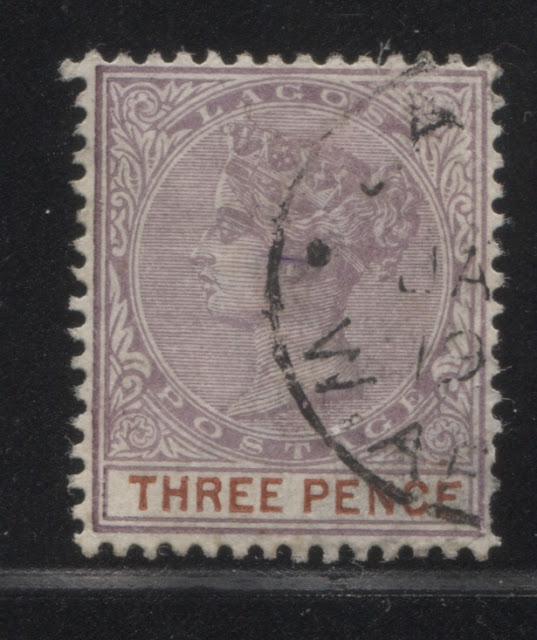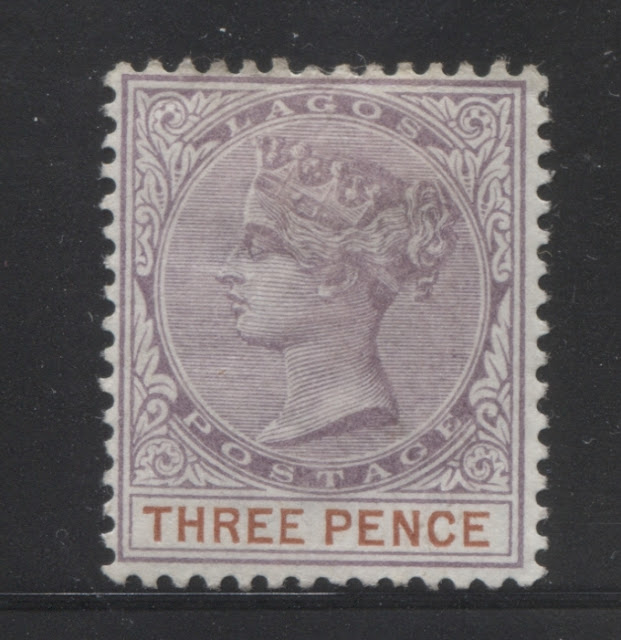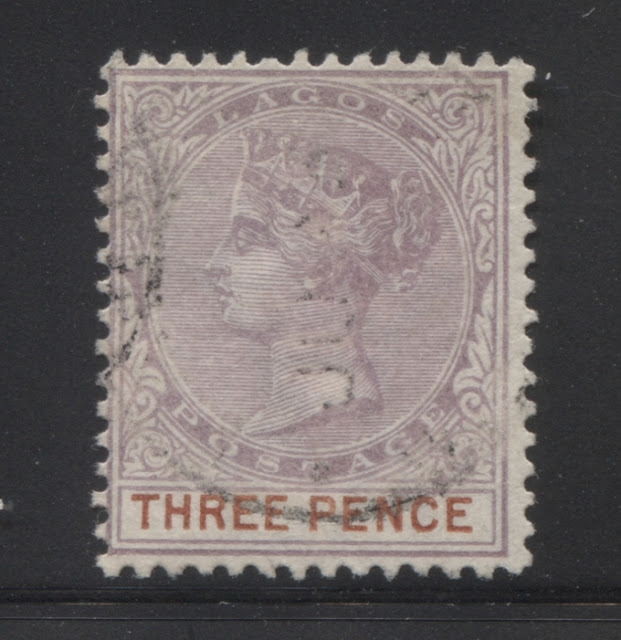Today's post continues my examination of the 1997-1903 issue of Lagos with the 3d lilac and orange brown, which was first dispatched to the colony on December 19, 1890. There were 143,820 stamps sent between that date and August 19, 1901, of which 85,800 remainders were sent back and destroyed. Like the other values that I have examined so far, I believe that there were probably lots of small printings of between 3,500 and 5,000 stamps, which would mean more than 20 printings. We'll see how many are revealed in this post. However, it must be borne in mind that I may not have an example of every printing that there was, and that there may have been more than just what I have here.
I have 121 mint and used stamps of this value, which I initially sorted into the same five groups that I had identified in the posts dealing with the 5d, 7.5d, and 10d stamps. Interestingly, I did not find any stamps that possessed the characteristics of plate 2, which suggests that all printings were made from plate 1. Within the first group however, there was one that showed every so slightly less plate wear than the others, and which I believe represents the printings made between December 1890 and December 1892. They are much scarcer than the later printings, and I do not believe that I have examples of all that were printed in these early years before 1894. I sorted each of the first five groups further by the shades of the head plate and duty plates (words of value) into printings. I will now illustrate them and describe their characteristics. Once again, I do not have a sufficient number of dated used examples to be certain about the order of the printings, so when I refer to a printing as the "fourth printing", I mean the fourth printing that I identified - not necessarily the fourth printing made. In all, I believe I have identified 31 printings of this value.
Group 1 - Printings 1-3
Like the first printings of the 5d, 7.5d, and 10d, these three printings show only minimal plate wear, with slight merging of the first three lines at the very top of the hair on two of the three. The very first printing does not show the merging of these lines, and it is my belief that this printing comes from the period between December 1890 and the end of 1893.
First Printing
Second Printing
Third Printing
The head plate colour on this printing is completely different again, being almost an exact match to Gibbons' dull purple. The duty plate colour is closest to chestnut.
Group 2 - Printings 4-11
In this group of printings, they are similar to the first, but there is a slight loss of sharpness, with the most noticeable being the first shading lines near the jewels of the crown.
Fourth Printing
Fifth Printing
Sixth Printing
Seventh Printing
The head plate shade on this printing is tricky as it is not an exact match of any swatch on the Gibbons colour key. It is duller than the lilac and reddish lilac shades and lacks the brown that is present in the dull purple. I would say that it is closest to how the slate-lilac swatch would look if a considerable amount of white were added to the colour. So it is a pale slate-lilac. The duty plate colour is closest to chestnut. The sole used example, which I believe is a little faded, is dated 1898.
Eighth Printing
Ninth Printing
Tenth Printing
Eleventh Printing
Group 3 - Printings 12-18
The printings of the third group are characterized by the lack of detail in the hair in the back of the head, the merging of the top four or five hairlines at the top of the head, and the merging of most of the lower hairlines up to about half way up the jewels in the crown.
Twelfth Printing
Thirteenth Printing
The head plate colour of this printing is also tricky as it does not quite match the lilac swatches, being both a touch greyer and duller. However, it is not anywhere near as dull as the grey-lilac and it lacks the brownish tinge that it would have to have in order to be a paler version of the dull purple. So I am going to call this dull lilac. The duty plate colour is closest to lake brown, but is just a touch deeper.
This printing is, by far the one that I have the largest number of examples of, with 12 mint and 11 used. Of the used examples, 5 examples are dated between 1902 and 1903, while four appear to be cancelled with a 9-bar oval obliterator. Again, this suggests that the dated examples are late usages, because the plate just does not show anywhere near enough wear to be from 1902 or 1903.
The scan below shows a close-up of three of the examples from above:
Fourteenth Printing
Fifteenth Printing
The head plate colour of this printing is closest to reddish lilac on the Gibbons colour key, while the duty plate colour is closest to orange-brown.
I have three used examples of this printing. The stamp on the left is cancelled 1900 or later, which, once again is likely a late usage. The stamp in the middle is cancelled in 1892, which suggests to me at least, that there may not truly have been 15 printings in just under two years, although there certainly could have been eight. The stamp on the right is cancelled with a 9-bar oval obilterator, which is consistent with a pre-1898 printing.
Sixteenth Printing
The head plate colour of this printing is closest to dull purple, while the duty plate colour is closest to chestnut.
None of the above three used examples show a clear date, but two are cancelled with 9-bar oval obliterators, which suggests that these were printed before 1899.
Seventeenth Printing
Here the head plate colour is closest to dull mauve, while the duty plate colour is closest to chestnut. Again, the only used example in my possession is cancelled with a 9-bar oval obliterator, which suggests that it was made prior to 1899.
Eighteenth Printing
The head plate colour of this printing is closest to what I called dull lilac on the thirteenth printing. The duty plate colour is closest to lake brown, but just a touch paler.
The head plate shade of these three used examples is rosier than the mint examples, but I think that all three of these have been slightly affected by water. The only readable date is on the middle stamp, and it is only a partial date that is sometime in the 1890's, probably between 1897 and 1899.
Group 4 - Printings 19-26
These printings are characterized by the fact that while nearly all the detail in the hair up to the top of the crown is gone, there is still a narrow band of detail visible between the top of the crown and the top of the head. Also, the horizontal shading lines in the lower horizontal band of the crown are still visible, but just beginning to merge into one another.
Nineteenth Printing
On this printing, the head plate colour is closest to dull mauve, but just a touch rosier. The duty plate colour is closest to orange-brown, but just a little paler. The used example on the right is dated 1902, which is still late for a group 4 printing.
Twentieth Printing
Twenty First Printing
Twenty Third Printing
The head plate colour on this printing remains closest to dull mauve, while the duty plate colour is closest to chestnut.
Twenty Fourth Printing
The head plate colour of this printing is still closest to dull mauve. The duty plate colour is closest to red-brown, but paler. It is actually mid-way between red-brown and lake brown.
Twenty Fifth Printing
The head plate colour of this printing is closest to reddish lilac, but is paler. The duty plate colour is closest to lake brown. The dates of these examples are all indistinct, and they are all used. So there is a possibility that these are simply examples of another printing, like say the 22nd printing, that have been affected by exposure to water.
Twenty Sixth Printing
Group 5 - Printings 27-31
This printing is distinct in that there is a coarseness of appearance that none of the preceding printings have. The detail in the hair at the top of the head is almost completely gone, and most of the shading lines in the lower horizontal band of the crown are completely merged together.
Twenty Seventh Printing
The head plate colour of this printing is closest to reddish lilac. The duty plate shade is about mid-way between deep chestnut and lake brown.
These used examples are all dated in 1902, which is relatively contemporary. In all likelihood this printing was probably made sometime in late 1899 or early 1900, and these are all used within 2 years of receipt.
Twenty Eighth Printing
Twenty Ninth Printing
The head plate colour of this printing is closest to reddish lilac. The duty plate colour is closest to lake brown.
Thirtieth Printing
The head plate colour of this printing is very close to slate-lilac, but is just a touch paler. The head plate shade is closest to chestnut.
Thirty First Printing
I have 121 mint and used stamps of this value, which I initially sorted into the same five groups that I had identified in the posts dealing with the 5d, 7.5d, and 10d stamps. Interestingly, I did not find any stamps that possessed the characteristics of plate 2, which suggests that all printings were made from plate 1. Within the first group however, there was one that showed every so slightly less plate wear than the others, and which I believe represents the printings made between December 1890 and December 1892. They are much scarcer than the later printings, and I do not believe that I have examples of all that were printed in these early years before 1894. I sorted each of the first five groups further by the shades of the head plate and duty plates (words of value) into printings. I will now illustrate them and describe their characteristics. Once again, I do not have a sufficient number of dated used examples to be certain about the order of the printings, so when I refer to a printing as the "fourth printing", I mean the fourth printing that I identified - not necessarily the fourth printing made. In all, I believe I have identified 31 printings of this value.
Group 1 - Printings 1-3
Like the first printings of the 5d, 7.5d, and 10d, these three printings show only minimal plate wear, with slight merging of the first three lines at the very top of the hair on two of the three. The very first printing does not show the merging of these lines, and it is my belief that this printing comes from the period between December 1890 and the end of 1893.
First Printing
On this printing, which I believe is at least the first of the ones I have identified, the head plate colour is closest to dull mauve on the Stanley Gibbons colour key, while the duty plate colour is closest to lake-brown. The head plate colour is just a touch deeper than the dull mauve, but it is very close to an an exact match.
Second Printing
The head plate colour on this printing is closest to the reddish lilac swatch on the Gibbons colour key, being almost an exact match, in fact. The duty plate colour is closest to lake brown also, but there is just the smallest hint of a bit more red in this colour compared to the first printing. The cancellation is a German ship cancellation that appears to be from 1900 - a good ten years after this stamp was issued. So either this is a plate 2 printing, or it is a late use of an early plate 1 printing. It is quite possible, given the large number of late usages of these stamps for this to be an example. This one shows an interesting variety - a burr on the "C" of "Pence". It is the only stamp out of the 121 examples here to show this variety, so I am not sure if it is constant or not.
Third Printing
The head plate colour on this printing is completely different again, being almost an exact match to Gibbons' dull purple. The duty plate colour is closest to chestnut.
Group 2 - Printings 4-11
In this group of printings, they are similar to the first, but there is a slight loss of sharpness, with the most noticeable being the first shading lines near the jewels of the crown.
Fourth Printing
The head plate colour on this printing is also closest to dull purple, but is just a touch paler and redder than the colour of the third printing. The duty plate colour is closest to orange-brown on the Gibbons colour key. The used example again has a German ship cancellation and the date is either 1897 or 1907, which would be another example of a late usage in either case.
Fifth Printing
Like the first printing, the head plate colour of this printing is also closest to dull mauve, while the duty plate colour is also closest to lake-brown. The cancellation is indistinct, but appears to be an 8-bar oval, which is consistent with it being a pre-1899 printing.
Sixth Printing
On this printing, the head plate colour is also closest to dull mauve. The duty plate colour is closest to lake brown, but on this printing the colour contains just a bit more brown. However, it is not brown enough to be reddish brown. The used example shown here has a Lagos CDS cancel. I can just make out a "4" at the end of the date, which suggests that it was used in 1894. There is a small possibility that the date is 1904, but by then the style of cancellation most commonly in use had changed.
Seventh Printing
The head plate shade on this printing is tricky as it is not an exact match of any swatch on the Gibbons colour key. It is duller than the lilac and reddish lilac shades and lacks the brown that is present in the dull purple. I would say that it is closest to how the slate-lilac swatch would look if a considerable amount of white were added to the colour. So it is a pale slate-lilac. The duty plate colour is closest to chestnut. The sole used example, which I believe is a little faded, is dated 1898.
Eighth Printing
The head plate colour on this printing is closest to pale slate-lilac.The duty plate colour, like the last printing is closest to chestnut, but just a touch deeper.
Ninth Printing
The head plate colour of this printing is closest to pale-slate lilac, while the duty plate colour is closest to chestnut.
Tenth Printing
The head plate colour of this printing is closest to dull purple, while the duty plate colour is closest to orange-brown.
Eleventh Printing
The head plate colour of this printing is closest to pale slate-lilac, while the duty plate colour is closest to lake brown, but just a bit paler.
Group 3 - Printings 12-18
The printings of the third group are characterized by the lack of detail in the hair in the back of the head, the merging of the top four or five hairlines at the top of the head, and the merging of most of the lower hairlines up to about half way up the jewels in the crown.
Twelfth Printing
On this printing, the head plate colour is closest to dull mauve, while the duty plate colour is closest to orange brown, but just a touch paler.
Thirteenth Printing
The head plate colour of this printing is also tricky as it does not quite match the lilac swatches, being both a touch greyer and duller. However, it is not anywhere near as dull as the grey-lilac and it lacks the brownish tinge that it would have to have in order to be a paler version of the dull purple. So I am going to call this dull lilac. The duty plate colour is closest to lake brown, but is just a touch deeper.
This printing is, by far the one that I have the largest number of examples of, with 12 mint and 11 used. Of the used examples, 5 examples are dated between 1902 and 1903, while four appear to be cancelled with a 9-bar oval obliterator. Again, this suggests that the dated examples are late usages, because the plate just does not show anywhere near enough wear to be from 1902 or 1903.
The scan below shows a close-up of three of the examples from above:
Fourteenth Printing
The head plate colour of this printing is closest to pale slate-lilac, while the duty plate colour is closest to chestnut. Both used examples have the same Lagos cancellation from September 24, 1895.
Fifteenth Printing
The head plate colour of this printing is closest to reddish lilac on the Gibbons colour key, while the duty plate colour is closest to orange-brown.
I have three used examples of this printing. The stamp on the left is cancelled 1900 or later, which, once again is likely a late usage. The stamp in the middle is cancelled in 1892, which suggests to me at least, that there may not truly have been 15 printings in just under two years, although there certainly could have been eight. The stamp on the right is cancelled with a 9-bar oval obilterator, which is consistent with a pre-1898 printing.
Sixteenth Printing
The head plate colour of this printing is closest to dull purple, while the duty plate colour is closest to chestnut.
None of the above three used examples show a clear date, but two are cancelled with 9-bar oval obliterators, which suggests that these were printed before 1899.
Seventeenth Printing
Here the head plate colour is closest to dull mauve, while the duty plate colour is closest to chestnut. Again, the only used example in my possession is cancelled with a 9-bar oval obliterator, which suggests that it was made prior to 1899.
Eighteenth Printing
The head plate colour of this printing is closest to what I called dull lilac on the thirteenth printing. The duty plate colour is closest to lake brown, but just a touch paler.
The head plate shade of these three used examples is rosier than the mint examples, but I think that all three of these have been slightly affected by water. The only readable date is on the middle stamp, and it is only a partial date that is sometime in the 1890's, probably between 1897 and 1899.
Group 4 - Printings 19-26
These printings are characterized by the fact that while nearly all the detail in the hair up to the top of the crown is gone, there is still a narrow band of detail visible between the top of the crown and the top of the head. Also, the horizontal shading lines in the lower horizontal band of the crown are still visible, but just beginning to merge into one another.
Nineteenth Printing
On this printing, the head plate colour is closest to dull mauve, but just a touch rosier. The duty plate colour is closest to orange-brown, but just a little paler. The used example on the right is dated 1902, which is still late for a group 4 printing.
Twentieth Printing
The head plate colour of this printing is closest to dull purple, while the duty plate colour is closest to chestnut. The used stamp on the right is the most troubling because the date is clearly 1891, but the impression is far too worn for it to have come from such an early date. This leads me to wonder whether the hammer used for the cancellation was set to the wrong date, and whether the postal clerk really meant to set it to 1901 and not 1891.
Twenty First Printing
On this printing, the head plate colour is closest to dull mauve, while the duty plate colour is closest to orange brown. The used example shown here appears to be cancelled with a 9-bar oval, which suggests that it is from before 1899.
Twenty Second PrintingThe head plate colour on this printing continues to be closest to the dull mauve swatch on the Gibbons colour key. The duty plate colour is closest to lake brown.
Here I show eight used examples in my possession. Again, all the dates that I can read here are 1902-1904, while there are also examples with barred oval obliterators.
Twenty Third Printing
The head plate colour on this printing remains closest to dull mauve, while the duty plate colour is closest to chestnut.
Twenty Fourth Printing
The head plate colour of this printing is still closest to dull mauve. The duty plate colour is closest to red-brown, but paler. It is actually mid-way between red-brown and lake brown.
Twenty Fifth Printing
The head plate colour of this printing is closest to reddish lilac, but is paler. The duty plate colour is closest to lake brown. The dates of these examples are all indistinct, and they are all used. So there is a possibility that these are simply examples of another printing, like say the 22nd printing, that have been affected by exposure to water.
Twenty Sixth Printing
This printing is tricky. The head plate colour is closest to the reddish lilac swatch of the Gibbons colour key, but it is much rosier. However, it is not as rosy as the mauve, claret or rose-lilac swatches. So I would call this a rosy reddish lilac. This is used, so there is a chance that this is not the true colour and that the rosy undertone is caused by the fading of the doubly fugitive ink. The duty plate shade is closest to chestnut, but deeper. This is a very unusual shade for the head plate, and given that it is used and shows clear signs of being affected by the cancellation ink, there is also a possibility that it has been affected by moisture.
Group 5 - Printings 27-31
This printing is distinct in that there is a coarseness of appearance that none of the preceding printings have. The detail in the hair at the top of the head is almost completely gone, and most of the shading lines in the lower horizontal band of the crown are completely merged together.
Twenty Seventh Printing
The head plate colour of this printing is closest to reddish lilac. The duty plate shade is about mid-way between deep chestnut and lake brown.
These used examples are all dated in 1902, which is relatively contemporary. In all likelihood this printing was probably made sometime in late 1899 or early 1900, and these are all used within 2 years of receipt.
Twenty Eighth Printing
The head plate colour of this printing is pale slate-lilac, while the duty plate shade is deep chestnut.
Twenty Ninth Printing
The head plate colour of this printing is closest to reddish lilac. The duty plate colour is closest to lake brown.
The date on this single used example is after 1900, though we can't tell how late after. However, it is clearly a contemporary cancel.
Thirtieth Printing
The head plate colour of this printing is very close to slate-lilac, but is just a touch paler. The head plate shade is closest to chestnut.
Thirty First Printing
On this printing, the head plate colour is almost an exact match for dull mauve, while the duty plate colour is closest to lake brown, but a bit paler. Unfortunately there is no clear date on this one, but I would suspect that this was probably one of the last printings made, if not the last one.
Conclusion
This was the most troubling stamp of all the denominations that I have examined in this series so far. There seem to be so many late dates on the used examples that either my theory about the wear of the plates is incorrect, and use of plate characteristics to place the printings is incorrect, because the plate did not actually wear evenly, as I have assumed, or there were so many shipments of these stamps, that were received so frequently, that early printings frequently got left at the bottom of the pile and were not used until much later. Given that the number of unsold remainders in 1903 was more than half of the original sending, I think it is safe to conclude that the later hypothesis is correct: that many early printings simply did not get sold over the post office counters until much later after they were first received. What I have managed to establish though is that there was a state of the plate in which there is no merging of the lines in the shading of the hair. I didn't come across this on any of the 5d, 7.5d or 10d values, which suggests that it pre-dates these stamps, and that any stamp showing these characteristics has to have been printed before 1894.
Next week's post will look at the 2.5d ultramarine that was issued in April 1891.
Conclusion
This was the most troubling stamp of all the denominations that I have examined in this series so far. There seem to be so many late dates on the used examples that either my theory about the wear of the plates is incorrect, and use of plate characteristics to place the printings is incorrect, because the plate did not actually wear evenly, as I have assumed, or there were so many shipments of these stamps, that were received so frequently, that early printings frequently got left at the bottom of the pile and were not used until much later. Given that the number of unsold remainders in 1903 was more than half of the original sending, I think it is safe to conclude that the later hypothesis is correct: that many early printings simply did not get sold over the post office counters until much later after they were first received. What I have managed to establish though is that there was a state of the plate in which there is no merging of the lines in the shading of the hair. I didn't come across this on any of the 5d, 7.5d or 10d values, which suggests that it pre-dates these stamps, and that any stamp showing these characteristics has to have been printed before 1894.
Next week's post will look at the 2.5d ultramarine that was issued in April 1891.


